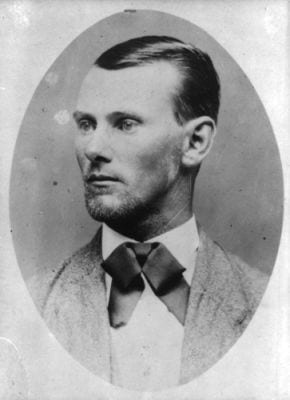 Jesse James
Jesse James
Editor’s note: This post has been corrected from the original, which gave the incorrect location of Jesse James’ grave.
One of the most engaging features of 23andMe’s Personal Genome Service is a customer’s ability to trace his or her genetic ancestry using the mitochondrial DNA and the Y-chromosome.
Once customers learn their own ancestry, the Genome Sharing feature allows them to see how they compare with friends and family.
However, the ancestry section of 23andMe also allows customers to see how they compare to well-known individuals. In the maternal and paternal ancestry features, customers can view the haplogroup assignments of such figures as Thomas Jefferson, Genghis Khan and Bono.
Am I Related to Someone Famous? Sort of.
But how can anyone know the ancestry of someone like Thomas Jefferson, who has been dead for a few hundred years, or Genghis Khan, who has been dead for close to a thousand?
It turns out there are several ways to find out these well-known figures’ ancestry. The most obvious: Celebrities can sign up for 23andMe’s Personal Genome Service, just like the rest of us! For example, Jimmy Buffett and Warren Buffett have been interested for years in finding out whether their shared surname was an indication of common genetic ancestry. Unfortunately, their genetic profiles show the two are not closely related.
Founding Fathers’ Haplogroups
But what about people like Thomas Jefferson?
He is no 23andMe customer, but this does not mean that scientists cannot trace his ancestry by other means. Tracing the maternal or paternal ancestry of any deceased individual is usually done by one of two ways: either getting DNA from the physical remains of the individual, or getting DNA from direct descendants of a relevant lineage.
He is no 23andMe customer, but this does not mean that scientists cannot trace his ancestry by other means. Tracing the maternal or paternal ancestry of any deceased individual is usually done by one of two ways: either getting DNA from the physical remains of the individual, or getting DNA from direct descendants of a relevant lineage.
In the cases of Thomas Jefferson and Benjamin Franklin, scientists used DNA from direct descendants of their ancestors. For example, in 1998 scientists inferred Jefferson’s paternal ancestry by analyzing the Y-chromosome of direct descendants of Jefferson’s paternal uncle (Jefferson had no confirmed sons).
Marie Antoinette and other Royal Haplogroups
Likewise, in the case of historical royalty such as Tsar Nicholas II of Russia or Marie Antoinette of France, extensive and detailed royal pedigrees make finding direct descendants a breeze.
Likewise, in the case of historical royalty such as Tsar Nicholas II of Russia or Marie Antoinette of France, extensive and detailed royal pedigrees make finding direct descendants a breeze.
In the case of the infamous outlaw Jesse James, a more direct approach was used. It had been widely believed that after James died in 1882, his body was buried at Mt. Olivet Cemetery in Kearney, Missouri. In order to test this hypothesis, scientists exhumed the body, extracting a few teeth. They compared DNA from the teeth to that of the great-grandson and great great-grandson of James’ sister. Scientists found an exact match between the extracted teeth and James’ sister’s descendants, thus confirming that the body in Mt. Olivet Cemetery was most likely that of Jesse James and establishing his ancestry to boot.
How about Genghis Khan?
He is listed in our famous people sidebar as being a member of Y-chromosome Haplogroup C. But we do not have any information on his direct descendants alive today, nor do we have any preserved remains of his body. However, scientists have examined the Y-chromosomes of many present-day inhabitants of Mongolia (the ancestral home of Genghis Khan).
In doing so, they have found that about 8% of Mongolian males share the exact same DNA pattern in a highly variable part of their Y-chromosomes. Further analysis has revealed that this particular Y-chromosome type, which falls into haplogroup C, originated about 1,000 years ago and that its dispersal across Central Asia corresponds to the boundaries of the Mongol Empire. Historians have long noted Khan’s prolific nature; he is rumored to have fathered more than 40 sons, with some of his descendants also fathering many sons of their own. So it’s a good bet that we’re seeing Genghis Khan’s legacy in the 8% of Mongolian males alive today who have identical Y-chromosome signatures.
There are a number of ways we can determine the haplogroups of well-known figures — both past and present — and displaying information about these individuals adds to the fun of understanding and comparing the genetic ancestry of ourselves, our friends and family, and the rich and famous (or infamous).
Explore the origins of your ancestry at 23andMe.com.



